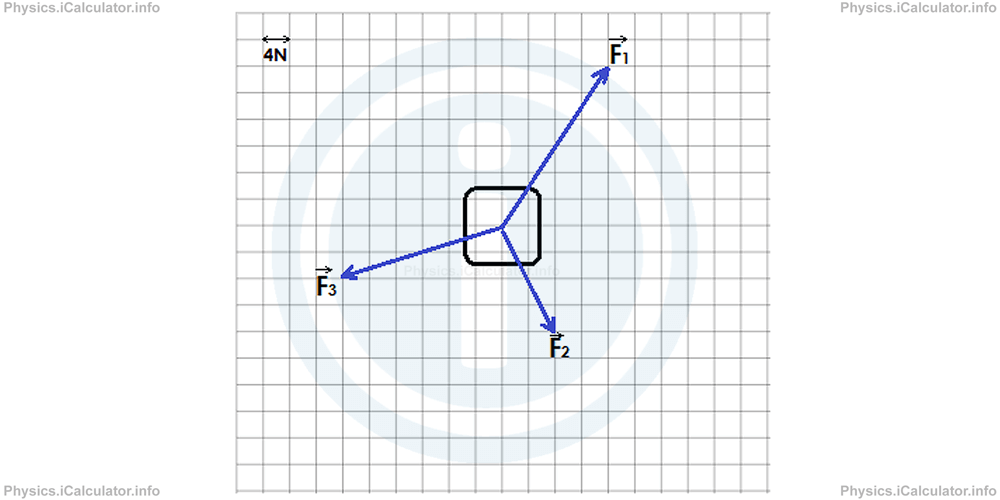Menu
Physics Lesson 4.1.4 - Expressing Forces in Components
Please provide a rating, it takes seconds and helps us to keep this resource free for all to use
Welcome to our Physics lesson on Expressing Forces in Components, this is the fourth lesson of our suite of physics lessons covering the topic of What Causes Motion? The Meaning of Force, you can find links to the other lessons within this tutorial and access additional physics learning resources below this lesson.
Expressing Forces in Components
When two or more forces acting at the same object are neither in the same direction nor in the opposite, it is better to express them in components. Then, after calculating the resultant force in each direction, the Pythagorean Theorem is used to calculate the magnitude of the resultant force. Let's illustrate this point by a numerical example.
Example 2
Calculate the resultant force F⃗R acting at the object in the figure.

Solution 2
From the figure, we can see that 1 unit = 4 N.
First, let's express all forces in components. We have two directions involved here: the horizontal (or x-direction) and the vertical (y-direction). Also, we take left as negative and right as positive in the horizontal direction and up as positive and down as negative in the vertical direction. Therefore, we can write:
F1y = ( + 6) units × 4 N/unit = + 24 N
F2x = ( + 2) units × 4 N/unit = + 8 N
F2y = (-4) units × 4 N/unit = -16 N
F3x = (-6) units × 4 N/unit = -24 N
F3y = (-2) units × 4 N/unit = -8 N
Thus, we have for the resultant forces of the each direction
= ( + 16)N + ( + 8)N + (-24)N
= 0
FRy = F1y + F2y + F3y
= ( + 24)N + (-16)N + (-8)N
= 0
In this case, there is no need to calculate the total resultant force because it is obvious it is zero (the object remains at rest). However, in the general case, we would write
= √02 + 02
= 0
Remark! When the object is voluminous as the one in the specific example, we take the force vectors as acting at the centre of the object.
You have reached the end of Physics lesson 4.1.4 Expressing Forces in Components. There are 4 lessons in this physics tutorial covering What Causes Motion? The Meaning of Force, you can access all the lessons from this tutorial below.
More What Causes Motion? The Meaning of Force Lessons and Learning Resources
Whats next?
Enjoy the "Expressing Forces in Components" physics lesson? People who liked the "What Causes Motion? The Meaning of Force lesson found the following resources useful:
- Components Feedback. Helps other - Leave a rating for this components (see below)
- Dynamics Physics tutorial: What Causes Motion? The Meaning of Force. Read the What Causes Motion? The Meaning of Force physics tutorial and build your physics knowledge of Dynamics
- Dynamics Revision Notes: What Causes Motion? The Meaning of Force. Print the notes so you can revise the key points covered in the physics tutorial for What Causes Motion? The Meaning of Force
- Dynamics Practice Questions: What Causes Motion? The Meaning of Force. Test and improve your knowledge of What Causes Motion? The Meaning of Force with example questins and answers
- Check your calculations for Dynamics questions with our excellent Dynamics calculators which contain full equations and calculations clearly displayed line by line. See the Dynamics Calculators by iCalculator™ below.
- Continuing learning dynamics - read our next physics tutorial: Types of Forces I. Gravitational Force and Weight
Help others Learning Physics just like you
Please provide a rating, it takes seconds and helps us to keep this resource free for all to use
We hope you found this Physics lesson "What Causes Motion? The Meaning of Force" useful. If you did it would be great if you could spare the time to rate this physics lesson (simply click on the number of stars that match your assessment of this physics learning aide) and/or share on social media, this helps us identify popular tutorials and calculators and expand our free learning resources to support our users around the world have free access to expand their knowledge of physics and other disciplines.